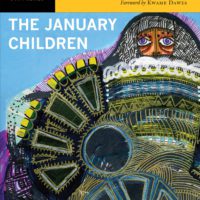After reading the first poem of Safia Elhillo’s The January Children, I simply wrote, Yes, after the last line and underlined it. Like so many books I love, Elhillo’s is an examination of betweenness. In its best moments—and there are many—and across poems, one feels the plummet of alienation that comes from partial belonging, and therefore, from not really belonging at all. In this regard, Elhillo brings to mind Sherman Alexie, another writer of identity betweenness. But where Alexie is centered on this continent, the center in The January Children is somewhere in the Atlantic. Identities divide and mix, with loyalties, affections, wounds, and angers pulling in competing directions (e.g. Sudan vs. Egypt vs. the US; American English vs. Arabic), and one feels a pervasive tenuousness that could drop the speaker into oceanic distance.
The opening poem, “asmarani makes prayer,” introduces many of the themes and strategies pursued throughout the book: “a border-shaped wound will / be licked clean by songs naming / the browngirl,” and, “when asked how / she got her name if telling the truth she / will say [a woman died & everything / wants a home].” In addition to its beguiling, haunting tone, the poem draws attention to borders and how they impinge on the body; the destroyed and ghosted past that shapes present identity; and the alienation of the speaker in her desire for a home. “asmarani makes prayer” also obliquely signals one of the organizational threads of the book: a series that traces the identity-forming influence of the late Egyptian singer, Abdelhalim Hafez, whose love songs are often addressed to a generic ‘brown girl.’ Hafez serves many roles in the book: the romantic other, the vessel of gendered romance norms, the representative of the oppressor, model of betweenness, vessel of beautiful but hollow assurances, etc. Elhillo’s speaker eventually must reckon with whether ‘brown girl’ includes her own shade of skin.
Three other organizational threads warrant mentioning: a series of erasures from interviews between Elhillo and members of the Sudanese Diaspora, the most important of which, as she explains in an end note, is with the poet’s mother; a series of self-portraits, which, as self-constructions, smartly counterbalance the erasures; and the reversal of a language diaspora across the book as her mother’s words, scattered throughout the poems, are gathered together again in her interview-as-erasure late in the book. The confluence of contradictions in this formal mix—erasure, construction, recovery—imparts a richness that creates a three-dimensional field in which identity can move and breathe, suffer and shift. The book’s subtle, across-the-book, formal elements are one reason I keep returning to it.
Throughout the book, Elhillo matches the formal choices of individual poems with a compelling voice. In unpunctuated lines with extra internal spaces that mark pauses, drags, and absences, Elhillo’s language tumbles and accumulates; it points and then emphatically points again; it betrays a relentless awareness of audience, and thereby reveals at least one psychological reality of betweenness. So “portrait with asylum,” which recounts community pain upon the deaths of two “sunday arabic school identitical twins beautiful boys,” after a heady list of community theories for why they died, reads:
__________________________ but all agreeing this would never have
happened if we’d never come to this godless country each still haunted
by the brother back home twenty years missing the husband shot in
the street daughters whipped through thin cotton blouses but ___back
home this would never have happened ________not both not both
In the extra spacing and repetition of “not both” there is palpable, measurable grief. Or, from another prose poem, untitled in the middle of the collection, there is this impeccable clinical assertiveness giving way to clinical resignation:
& what is a country but the drawing of a line _______i draw thick black
lines around my eyes & they are a country __& thick red lines around
my lips & they are a country __& the knife that chops the onions draws
a smooth line through my finger ____& that is a country
Taking into account her powerful voice and consistently perfect timing, it’s no surprise that Elhillo is a decorated performance poet.
Elhillo uses many elements of craft to create a sense of the realities of diaspora in The January Children, but I’ll focus on two that I find particularly adroit and compelling. Elhillo makes powerful use of rhetorical structures that hone down to distilled meaning. Such movement mimics a mind trying to claim the clarity and stability of definition. In “callback interview for the position / of abdelhalim hafez’s girl,” a poem in which the speaker responds to an interviewer’s questions about why she wants the fantastical job, the speaker replies “i guess you can say I have a type haunted men/dead men/men / marked to die… .” When the interviewer doesn’t understand, the speaker clarifies: “you know black i mean black.” This narrowing toward precise meaning is also writ large across the book, as the final poem functions as a distillation of the collection as a whole.
In addition, Elhillo also uses a fair amount of Arabic throughout the book, sometimes with translations and sometimes without. Both presence and absence produce rich poetic effects, even for readers, like me, who can’t read Arabic and don’t know the Arabic alphabet. Where Elhillo provides translations, the reader feels allowed into, if provisionally, the speaker’s world. Often the translations do double duty, functioning as reminders of Arabic word meanings to a speaker losing a language, while also providing contextual information to the reader. So, in “self-portrait with the question of race,” Elhillo provides a translation of a colloquial Sudanese racial insult, and throughout the collection, Elhillo provides (and is shaped by) her own translations of Hafez’s lyrics.
Translation is established as an early theme, strategy, and problem in “vocabulary,” the collection’s second poem, which brilliantly adapts the form of a multiple choice exam. We are told that the Arabic phoneme “/hawa/” can mean either “wind” or “love,” and then we are run through translations of lyrics that use it. We are given interpretations based on the two different translations and are asked to choose which is accurate—an impossible task—and here the reader feels keenly the dilemma of betweenness.
In poems where translation isn’t provided, the Arabic words act as silent icons for readers who don’t know Arabic. Here, some readers are made to feel the gap in sound, our distance from the speaker’s experiences, even when context clues tell us vaguely what the word indicates (an article of clothing, say). Because Elhillo early on indicates the speaker’s own language gaps in both Arabic and English, the reader is made to feel a kind of understanding within this absence, which is, to me, astounding.
And it is Elhillo’s consistent reaching across gaps—like Whitman’s soul “[c]easelessly musing, venturing, throwing, seeking the spheres to connect them”—that is most moving of all. Despite the omnipresence of the Sudanese Diaspora, the movement of the book is from absence to presence. As Kwame Dawes says in the introduction, “an act of erasure […] becomes a source of the imaginative act of regeneration.” The book, in the end, is shot through with a faith in human communion despite immense communal and individual loss.





